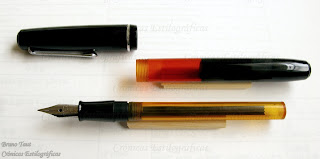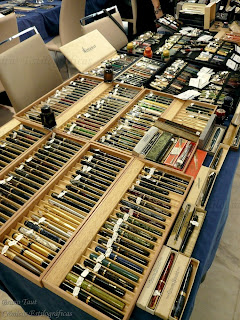Some months ago, I wrote a chronicle about a strange pen. A Pilot pen, actually, from 1938. Its most striking feature was a strangely long feed that entered well into the ink deposit for no apparent reason. This deposit, on its side, was screwed to the section. It really looked like a re-usable cartridge. But at the same time, it was also a sort of eyedropper pen with a reduced ink reservoir. That is why I named that chronicle as “Hybrid”.
Was I mistaken! Reality was a lot more exciting. And that is why my mistake was so sweet.

A short version of the previous pen, together with the nomikomi-shiki inkwell. These inkwells are really difficult to find nowadays.
This family of pens was released with an ad-hoc inkwell that allowed a very special and original filling procedure. This inkwell had a hole with a neck in the cap, inside which there are four sealing-rubber lips. To ink the pen, the user had to introduce it, uncapped, nib down, in the inkwell. Then, flip the inkwell and the pen upside down (crossing fingers for the rubber seal to work well, thus avoiding a massive ink spillage). Gravity and the capillarity of the extra-long feed worked together to fill the ink deposit very efficiently. This procedure, named nomikomi-shiki (呑込式) or, in English, easy-drink filler, can be seen on the following videoclip.
The pen used on this demonstration is a small version of the one I showed on my original, and mistaken, text. Both are made of celluloid, and have a window on the barrel to check the appropriate filling of the pen as well as the remaining ink. These are the dimensions of the short version of the nomikomi-shiki pen:
Closed: 103 mm.
Open: 94 mm.
Posted: 130 mm.
Diameter: 13 mm.
Indeed a sweet mistake as the reality proved to be a lot more interesting and original that mi initial guess.
My thanks to Mr. Niikura.
Platinum Celluloid, music nib – Sailor Kiwa-guro, 極黒
Bruno Taut
Madrid, December 11th, 2012
etiquetas: Pilot, soluciones técnicas
Bruno Taut
Madrid, December 11th, 2012
etiquetas: Pilot, soluciones técnicas












































